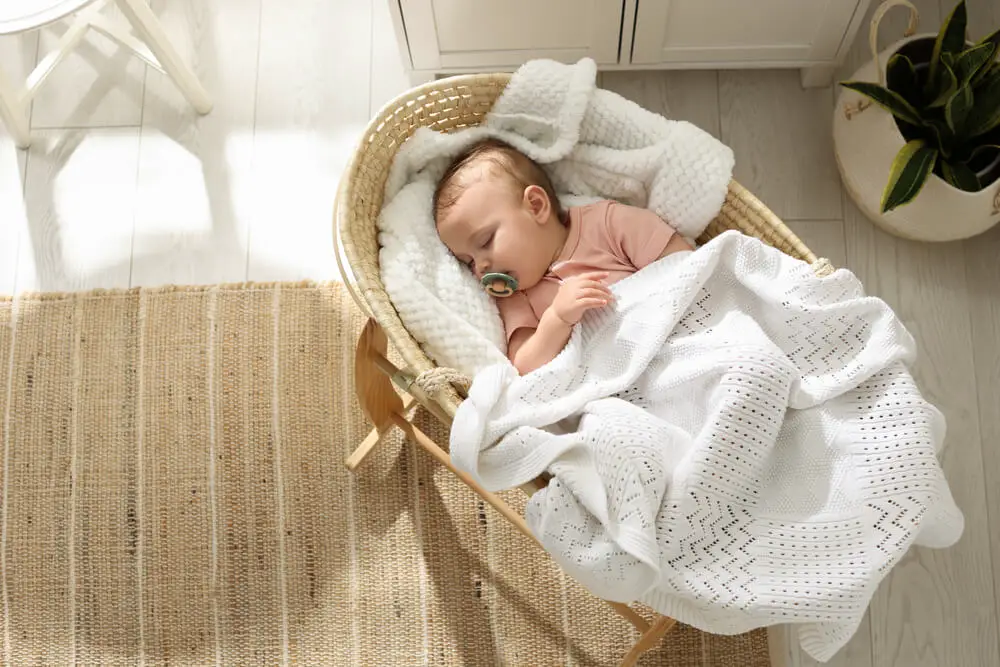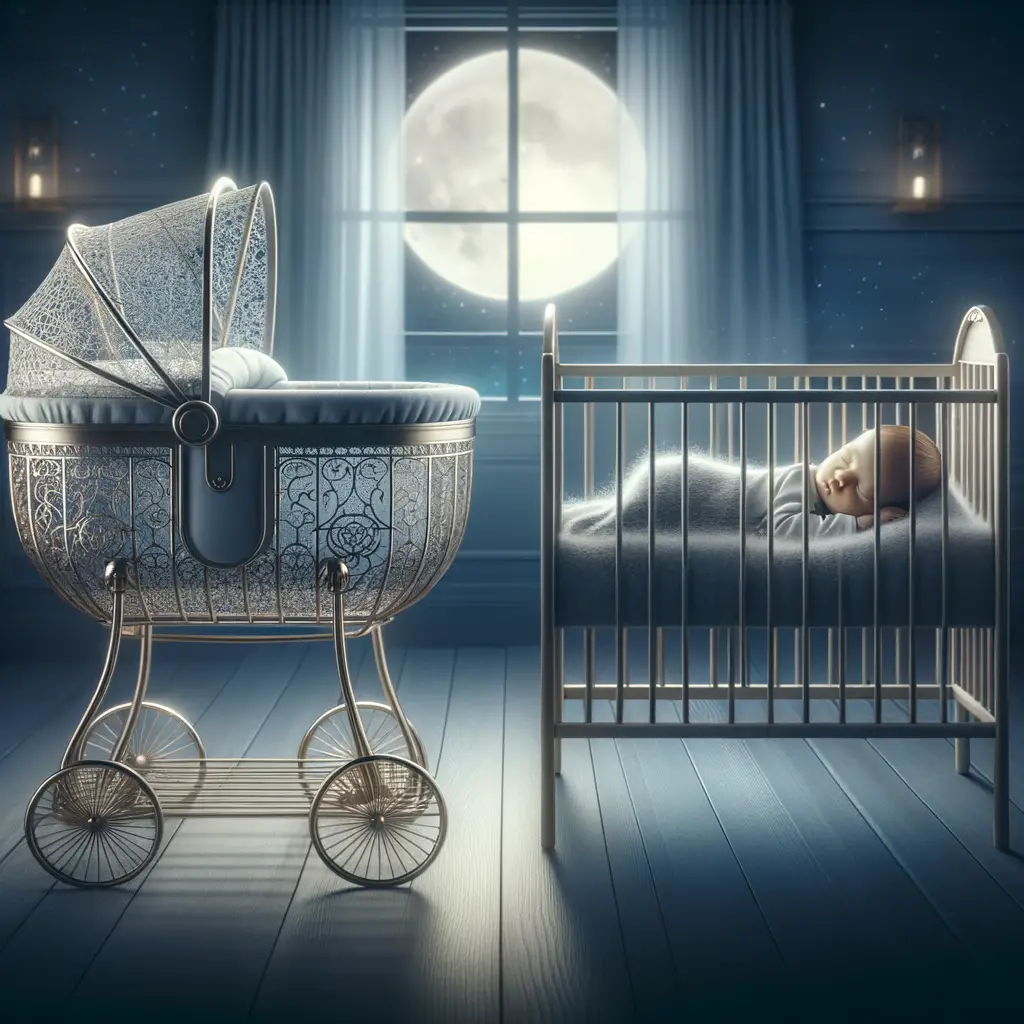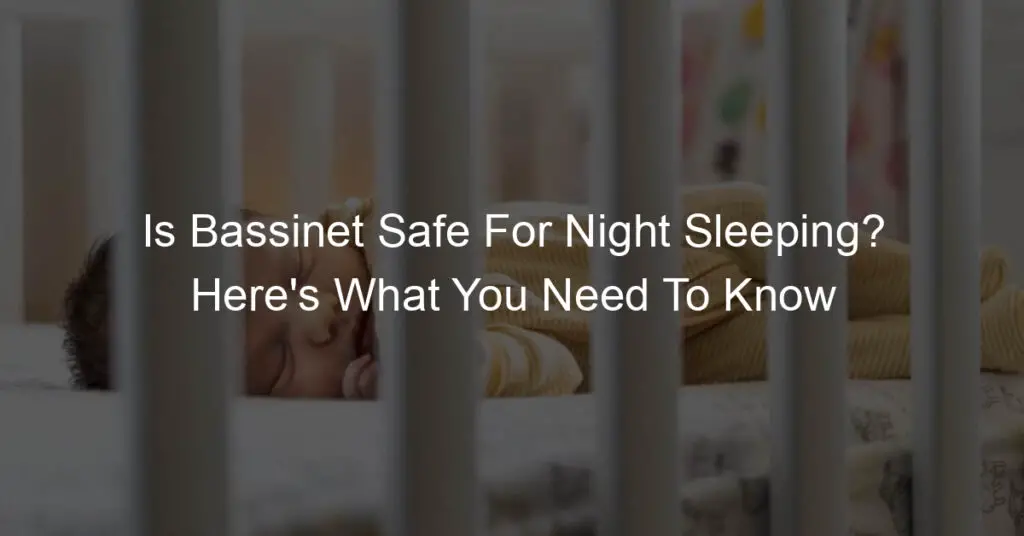Introduction to Baby Sleep Safety
Ensuring your baby’s safety during sleep is a crucial aspect of parenting. This article aims to provide you with comprehensive information on the importance of safe baby sleep and common concerns about nighttime safety for babies.
Importance of Safe Baby Sleep
Safe baby sleep is not just about comfort. It’s about preventing risks and ensuring healthy growth. According to the American Academy of Pediatrics, safe sleep can significantly reduce the risk of Sudden Infant Death Syndrome (SIDS). It’s also essential for the baby’s brain development, as the growth hormone is primarily secreted during deep sleep.
Common Concerns about Nighttime Safety for Babies
Many parents express concerns about their babies’ safety during the night. These concerns often revolve around the baby’s sleep position, the type of bedding used, and the room’s temperature. The fear of SIDS is also a common concern. To address these issues, it’s crucial to follow safe sleep guidelines, such as placing the baby on his or her back to sleep and keeping the crib free of loose bedding and soft objects.
Understanding and implementing baby sleep safety measures can give parents peace of mind and contribute to their baby’s overall well-being. In the following sections, we will delve deeper into the specifics of creating a safe sleep environment, including the use of bassinets and cribs.
Understanding Bassinets

When it comes to providing a safe and comfortable sleeping environment for your newborn, bassinets are a popular choice among parents. Let’s delve into understanding what a bassinet is and the common types you might come across.
What is a Bassinet?
A bassinet is a small, cozy bed specifically designed for infants, typically newborns up to four months old. It’s smaller than a crib and often comes with a hood or cover to protect the baby. Bassinets are designed to be portable and are often placed next to the parents’ bed for easy access during the night. You can learn more about bassinets on Wikipedia.
Definition of a bassinet:
A bassinet is a compact, portable bed designed for infants, usually from birth to about four months old. It provides a snug and secure sleeping environment for the baby, often featuring a hood or cover for added protection.
Common types of bassinets:
There are several types of bassinets available in the market. Some of the most common ones include:
Standard Bassinet:
This is a basic model with a simple design. It usually comes with a mattress and a hood.
Co-sleeper Bassinet:
This type of bassinet is designed to be attached to the side of the parents’ bed, making it easier for mothers to attend to the baby during the night.
Portable Bassinet:
These bassinets are lightweight and come with wheels or a handle, making them easy to move around the house or for travel.
Rocking Bassinet:
This type of bassinet is designed to gently rock the baby to sleep.
Choosing the right type of bassinet depends on your specific needs, lifestyle, and the space available in your home. Regardless of the type, safety should always be a top priority when selecting a bassinet for your baby.
Bassinet Safety Features
When choosing a bassinet for your precious little one, safety should be your top priority. Here are some key safety features to consider:
Sturdy Base
A bassinet should have a sturdy base to prevent it from tipping over. This is crucial because a wobbly bassinet can pose a risk to your baby’s safety. The base should be wide and stable, and the bassinet should not move or sway excessively when gently pushed.
Mesh Walls for Breathability
Mesh walls are another important safety feature. They allow for better air circulation, reducing the risk of suffocation. This feature is particularly important if your baby tends to roll towards the sides of the bassinet. Mesh walls also provide visibility, allowing you to keep an eye on your baby without having to get up.
Firm, Flat Mattress
The mattress in the bassinet should be firm and flat. A soft mattress can conform to the shape of your baby’s head or face, increasing the risk of suffocation or sudden infant death syndrome (SIDS). According to the American Academy of Pediatrics, a firm surface maintains its shape and will not indent or conform to the shape of the baby’s head when the baby is lying on it.
Proper Fit of Mattress and Sheets
The mattress should fit snugly within the bassinet with no gaps. Gaps can pose a risk as your baby can get trapped in them. The sheets used should also fit the mattress perfectly. Loose sheets can become a suffocation hazard. Always ensure to use sheets specifically designed for your bassinet’s mattress.
Remember, a safe bassinet is a simple one. Avoid bassinets with excessive padding, pillows, or stuffed animals, as these can pose suffocation risks. Always prioritize safety when choosing a bassinet for your baby.
Night Sleeping in a Bassinet

When it comes to ensuring a good night’s sleep for your newborn, a bassinet can be a great choice. Not only does it provide a cozy and secure space for your little one, but it also offers several benefits for you as a parent.
Benefits of Using a Bassinet for Nighttime Sleep
Let’s delve into the key advantages of using a bassinet for nighttime sleep:
Convenience for parents: A bassinet’s compact size and portability make it a convenient choice for parents. It’s easy to move around the house, allowing you to keep your baby close while you carry on with your daily tasks. Plus, the lower height of a bassinet compared to a crib makes it easier for you to reach in and soothe your baby during the night without having to get out of bed.
Comfort for newborns: Bassinets are designed with newborns in mind. They offer a snug and cozy environment that mimics the mother’s womb, helping your baby feel secure and promoting better sleep. The smaller size of a bassinet also prevents your baby from rolling over, which can be a concern with larger sleep spaces.
Reduced risk of SIDS: According to the American Academy of Pediatrics, room-sharing without bed-sharing can reduce the risk of sudden infant death syndrome (SIDS) by as much as 50%. A bassinet allows you to keep your baby in the same room as you without sharing the same bed, thus reducing the risk of SIDS.
In conclusion, a bassinet can be a practical and safe choice for nighttime sleep during your baby’s first few months. It offers convenience for parents, comfort for your newborn, and contributes to a safer sleep environment.
Potential Concerns and How to Address Them
While bassinets offer numerous benefits for newborns and their parents, there are a few potential concerns that you should be aware of. Let’s discuss these issues and provide some practical solutions.
Size Limitations
Bassinets are designed for newborns and small infants. As your baby grows, they may outgrow the bassinet. Most bassinets can accommodate babies up to 15 to 20 pounds. However, this can vary depending on the specific model. It’s essential to check the manufacturer’s weight limit and monitor your baby’s growth. Once your baby reaches the weight limit or can roll over or sit up, it’s time to transition to a crib.
Transitioning to a Crib
Moving your baby from a bassinet to a crib can be a challenging process. Start the transition gradually. You might begin by having your baby take daytime naps in the crib before moving to nighttime sleep. Make sure the crib is a safe and comfortable space. Use a firm mattress, keep the crib free of pillows, blankets, and stuffed animals, and ensure the crib slats are no more than 2 3/8 inches apart. For more information, you can refer to the crib safety guidelines on Wikipedia.
Safety Standards and Recalls
It’s crucial to ensure that the bassinet you choose meets all safety standards. Look for a certification seal from the Juvenile Products Manufacturers Association (JPMA). This indicates that the product has been tested for safety. Also, stay informed about product recalls. You can do this by registering your bassinet with the manufacturer or checking the list of product recalls on Wikipedia.
Bassinet vs Crib: A Comparative Analysis
When it comes to choosing a sleeping arrangement for your newborn, the decision between a bassinet and a crib can be challenging. Both have their unique advantages and disadvantages. Let’s delve into a comparative analysis to help you make an informed decision.
Pros and Cons of Bassinets
Understanding the pros and cons of bassinets is crucial for any parent. Here’s what you need to know:
Pros of using a bassinet for newborns
Bassinets are lightweight and portable, making them ideal for parents who want to keep their newborn close by during the night. They are also smaller than cribs, which can provide a cozy, womb-like environment that many newborns find comforting. Furthermore, bassinets are typically lower to the ground, making it easier for parents to reach in and soothe their baby during the night.
Cons of using a bassinet for newborns
One of the main drawbacks of bassinets is their limited lifespan. Most bassinets can only be used until the baby is around 4 to 6 months old, or until they start to roll over or sit up on their own. This means you’ll need to invest in a crib or another type of sleeping arrangement once your baby outgrows the bassinet. Additionally, because of their smaller size, bassinets offer less room for your baby to move around compared to a crib.
In conclusion, while bassinets offer convenience and a comforting environment for newborns, they have a shorter lifespan compared to cribs. It’s important to weigh these factors when deciding on the best sleeping arrangement for your baby.
Pros and Cons of Cribs
When it comes to creating a safe and comfortable sleeping environment for your newborn, cribs are often the go-to choice for many parents. However, like any other option, cribs have their own set of advantages and disadvantages. Let’s take a closer look:
Pros of using a crib for newborns
Cribs are designed to provide a safe and secure sleeping space for your baby. They are typically larger than bassinets, which means your baby has more room to move around. Cribs also tend to be more durable and can be used for a longer period of time as your child grows. Many cribs also come with adjustable mattress heights, allowing you to lower the mattress as your baby grows and becomes more mobile. This can help prevent your baby from climbing out of the crib and potentially getting hurt. According to a Wikipedia article, cribs are considered the safest sleeping environment for babies.
Cons of using a crib for newborns
Despite their many advantages, cribs do have some drawbacks. For one, they are typically more expensive than bassinets. They also take up more space, which can be a concern if you have a smaller home or apartment. Additionally, because cribs are larger and higher off the ground, it can be more difficult to lift your baby in and out, especially in the middle of the night. Lastly, while cribs are designed to be safe, they can still pose risks if not used correctly. For example, using a crib with drop-side rails, which have been banned in the U.S. due to safety concerns, can pose a risk of injury to your baby.
In conclusion, while cribs offer a safe and spacious sleeping environment for your baby, they also come with some potential drawbacks. It’s important to weigh these pros and cons when deciding on the best sleeping arrangement for your newborn.
Best Safe Bassinets: A Buyer’s Guide
When it comes to your baby’s safety, nothing is more important than choosing the right bassinet. It’s not just about comfort, but also about ensuring that your little one is safe and secure. Here are some key features to look for when buying a safe bassinet.
Key Features to Look for in a Safe Bassinet
JPMA certification
The Juvenile Products Manufacturers Association (JPMA) is an organization that certifies baby products for safety. A bassinet with JPMA certification has undergone rigorous testing to ensure it meets all safety standards. This certification is a good indicator that the bassinet is safe for your baby. You can learn more about JPMA certification here.
Sturdy construction
A bassinet should be well-built and sturdy. It should not wobble or tip over easily. The materials used should be durable and of high quality. A sturdy bassinet will not only last longer but also provide a safe and secure sleeping environment for your baby.
Mesh walls
Mesh walls are a safety feature that allows for better airflow and visibility. They prevent suffocation and allow you to easily see your baby from any angle. Mesh walls also reduce the risk of Sudden Infant Death Syndrome (SIDS).
Easy access for parents
A good bassinet should allow easy access for parents. This means it should be of a height that allows you to easily pick up and put down your baby. It should also have a removable or adjustable side for easy access during the night.
In conclusion, when buying a bassinet, prioritize safety over aesthetics. Look for JPMA certification, sturdy construction, mesh walls, and easy access for parents. These features will ensure that your baby has a safe and comfortable sleep environment.
Top 5 Bassinets for Newborn Sleep Safety
When it comes to your newborn’s sleep safety, the choice of a bassinet is crucial. Here are the top five bassinets that prioritize safety without compromising on comfort.
Halo Bassinest Swivel SleeperThe Halo Bassinest Swivel Sleeper is a top choice for many parents. It boasts a 360-degree swivel feature that allows you to easily access your baby while ensuring they have their own safe sleep space. The mesh walls provide breathability and visibility. Learn more about it here.
BabyBjorn CradleThe BabyBjorn Cradle is known for its sturdy construction and gentle rocking motion that soothes babies to sleep. It also features mesh walls for breathability and easy visibility. Find out more here.
Fisher-Price Soothing Motions BassinetThis bassinet from Fisher-Price offers soothing motions and calming vibrations that can help your baby fall asleep. It also includes a nightlight and music for added comfort. Read more about it here.
Graco Pack ‘n Play On the Go PlayardGraco’s Pack ‘n Play On the Go Playard doubles as a bassinet and a playard, making it a versatile choice. It’s easy to pack up and move, so your baby can have a safe sleep environment wherever you go. Discover more here.
Chicco LullaGo Portable BassinetThe Chicco LullaGo Portable Bassinet is lightweight and easy to disassemble, making it perfect for travel. It also includes mesh windows for ventilation and visibility. Learn more about it here.
Remember, the best bassinet for your baby is one that fits your specific needs and provides a safe, comfortable place for your baby to sleep. Always look for a JPMA certification to ensure the product meets safety standards.
Conclusion: Creating a Safe Sleep Environment for Your Baby
As we wrap up this comprehensive guide on baby sleep safety, let’s revisit some of the key points we’ve discussed and underscore the importance of creating a safe sleep environment for your little one.
Recap of Bassinet Safety
Throughout this guide, we’ve highlighted the importance of bassinet safety. Remember, the bassinet should be sturdy, with a firm, flat mattress and no loose bedding or toys that could pose a suffocation risk. The bassinet should also meet all the current safety standards set by the Consumer Product Safety Commission (CPSC).
Final Thoughts on Bassinet vs Crib
When it comes to choosing between a bassinet and a crib, it largely depends on your family’s needs and circumstances. Bassinets are compact and portable, making them ideal for parents who want to keep their baby close during the early months. Cribs, on the other hand, offer a long-term sleep solution and are a better investment for the future. Regardless of your choice, safety should always be the top priority.
Importance of Creating a Safe Sleep Environment for Babies
Creating a safe sleep environment for your baby is crucial to prevent sleep-related accidents and sudden infant death syndrome (SIDS). This involves choosing the right sleep equipment, following safe sleep practices, and maintaining a comfortable and hazard-free sleep area. Remember, a safe sleep environment is not just about the physical space; it’s also about the practices and routines that ensure your baby’s well-being.
In conclusion, the journey to ensuring your baby’s safety during sleep can seem daunting, but with the right information and careful planning, it can be a smooth and rewarding process. Remember, your baby’s safety is always worth the effort.














